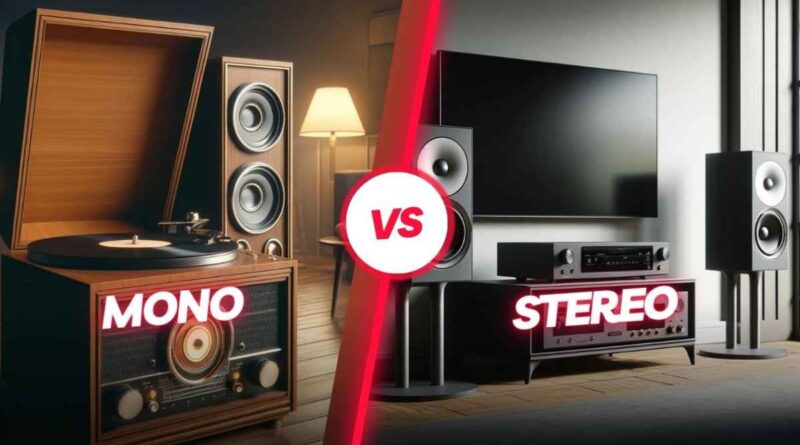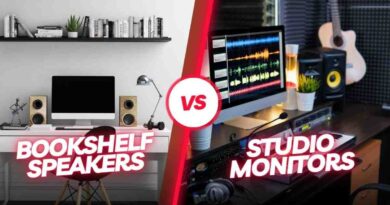Mono vs Stereo: What’s The Difference?
Ever wondered why some music sounds fuller and more alive, while other recordings seem flat and one-dimensional? The answer lies in how the sound is delivered: mono versus stereo. In this guide, we’ll break down the key differences between these two audio formats, exploring how many channels each uses and the impact it has on your listening experience. We’ll also look into situations where mono might be preferable, and when stereo truly shines.
What is Mono Sound?
Mono sound, short for monaural or monophonic sound, refers to audio that is mixed into a single channel. In mono, all sounds are combined into a single signal that is heard identically from all speakers or headphones.
- Technical Definition and Setup: Mono sound originates from a single point source. This means that no matter how many speakers you use, the same signal is fed through all of them, creating a singular auditory perspective.
- Common Uses: Mono is often used in settings where space or complexity is a concern, such as in radios, intercoms, and public address systems. It’s also prevalent in environments where the audience is spread out, such as at live speaking events, because it ensures that everyone hears the same sound no matter where they are located.
- Historical Context: Historically, mono was the first type of audio recording available. It dominated the recording industry until the late 1950s and early 1960s when stereo started to become popular.
Key Takeaways:
- Mono sound combines all audio into a single channel.
- It is ideal for uniform sound distribution in large or complex environments.
What is Stereo Sound?
Stereo, or stereophonic sound, uses two or more independent audio channels through a configuration of two or more speakers in such a way that creates a feeling of sound heard from various directions, as in natural hearing.
- Technical Definition and Setup: Stereo sound is created by using two distinct audio channels, typically referred to as the left and right channels. Each channel carries separate and distinct sounds that are recorded from different perspectives or locations.
- Common Uses: Stereo is the standard for most music and home theater systems. It provides a richer and more immersive listening experience by simulating how we perceive sounds naturally with two ears.
- Historical Context: Stereo sound became popular in the 1960s as recording techniques advanced. It allowed engineers to experiment with the spatial effects of sound, giving listeners a more dynamic experience.
Key Takeaways:
- Stereo sound uses two or more channels to create a multidimensional auditory experience.
- It enhances the realism and depth of audio playback, making it ideal for music and entertainment.
Comparing Mono and Stereo Sound Quality
When comparing the quality of mono and stereo, it’s essential to consider several factors like spatial clarity, detail, and suitability for different environments.
- Spatial Clarity: Stereo sound provides a spatial dimension that mono cannot achieve. This clarity allows listeners to pinpoint the location of an instrument or voice in a recording, providing a more engaging experience.
- Sound Detail: In stereo recordings, the separation of sound into two channels allows for greater detail and nuance in the audio. This separation can reveal subtle elements of the music or audio which might be lost in a mono mix.
- Environmental Suitability: Mono sound is less susceptible to the effects of sound wave cancellation and is more straightforward to set up in large or acoustically challenging environments. Therefore, it might be preferred in situations where detailed sound placement is less important than clear and consistent coverage.
Key Takeaways:
- Stereo offers superior spatial clarity and detail.
- Mono is more reliable in large or complex environments.
Applications of Mono and Stereo in Different Environments
Mono and stereo systems each have their specific applications where they excel. Understanding these can help you choose the right system for your needs.
- Home Audio: In home audio systems, stereo sound is generally preferred because it enhances the listening experience by providing a sense of space and depth that mono systems cannot.
- Public Address Systems: For public announcements in airports, schools, and other large venues, mono sound is often used. It ensures that the message is clearly delivered to all parts of the venue without the complications of stereo phasing issues.
- Recording Music: In music recording, stereo is typically used to capture the richness and positional cues of live instruments and vocals. However, mono recording can be beneficial for single sources like voiceovers or when a cohesive sound field is needed without any directional emphasis.
Key Takeaways:
- Stereo is ideal for home entertainment and music recordings where depth and spatial awareness are desired.
- Mono is suitable for public address systems and certain types of music recording where uniform sound distribution is required.
Influence of Mono and Stereo on Listener Fatigue
Listener fatigue is a significant consideration in audio production and playback. The setup of mono versus stereo can influence how quickly a listener may experience fatigue.
- Mono and Fatigue: Mono sound, being centered and less dynamic, tends to be less taxing on the ears over long periods. Since the sound comes from a single source, the brain does not have to process multiple auditory streams, which can reduce cognitive load.
- Stereo and Fatigue: In contrast, stereo sound, while providing a more immersive and realistic experience, can sometimes lead to quicker listener fatigue. This is due to the brain having to continuously process and place the sounds coming from multiple directions, which can be more demanding.
Application Tips: For environments where audio is played continuously, like in some retail spaces or during lengthy events, mono might be preferable to minimize fatigue. In settings where engagement and experience are more important, such as in home theaters or during concerts, stereo provides a more satisfying experience despite the potential for greater fatigue.
Key Takeaways:
- Mono sound may reduce listener fatigue due to its simpler auditory processing.
- Stereo, though more engaging, can potentially increase fatigue because of its complexity.
Compatibility with Hearing Aids
Mono and stereo systems also differ in their compatibility with hearing aids, which is crucial for ensuring accessibility in various settings.
- Mono Systems: Mono systems can be more straightforward for hearing aid users because the sound is uniform and there is no need to distinguish between different channels. This uniformity can make the audio clearer and easier to understand.
- Stereo Systems: Stereo systems, while offering a rich sound experience, can sometimes pose challenges for hearing aid users. If the hearing aid is not well adjusted to handle the stereo separation, it can lead to a confusing audio experience. However, modern hearing aids have adapted with technology that can process stereo sound more effectively.
Considerations for Public Spaces
In public spaces, it’s essential to consider the accessibility of audio systems. Providing mono sound options or ensuring that stereo systems are compatible with the latest hearing aid technology can help accommodate all listeners.
Key Takeaways:
- Mono is generally more compatible with hearing aids due to its uniform output.
- Stereo systems require more sophisticated hearing aids to provide clear and balanced sound to users.
Stereo Imaging and Depth Perception
The concept of stereo imaging and depth perception is central to the distinction between mono and stereo audio setups.
What is Stereo Imaging?
Stereo imaging refers to the ability of a stereo audio system to localize sound sources within a space. This creates the illusion of depth and distance, enhancing the realism of the audio experience.
- Mono Limitations: Mono recordings lack this dimensionality. They can represent distance through volume and tone but cannot spatially place sounds across the stereo field.
- Stereo Advantages: The advantage of stereo sound in terms of imaging and depth is significant in applications like virtual reality, video gaming, and film where the audio plays a crucial role in immersing the user in a multi-dimensional environment.
Durability and Maintenance of Audio Systems
Considering the durability and maintenance of mono and stereo systems is essential for long-term audio setup planning.
- System Complexity and Maintenance: Generally, mono systems are simpler and often more durable due to having fewer components. This simplicity translates into easier maintenance and potentially longer system life.
- Stereo Systems: Stereo systems, with more components and connections, can be more susceptible to issues like cable interference or component failure. However, with proper care, they can also provide many years of quality sound.
Best Practices:
Regular maintenance, such as checking connections, updating equipment, and cleaning, is vital for both mono and stereo systems to ensure optimal performance and longevity.
Key Takeaways:
- Mono systems tend to be more durable and easier to maintain due to their simplicity.
- Stereo systems require more meticulous maintenance but can offer superior audio quality if well-maintained.
Best Applications for Mono and Stereo in Professional Settings
In professional audio settings, the choice between mono and stereo can impact the quality and delivery of the sound. Here’s how each is best utilized:
- Broadcasting: For broadcasting environments like radio and television, stereo is often preferred because it provides a more dynamic and appealing sound to listeners and viewers. However, mono is used for speech-heavy content, ensuring clarity and intelligibility for all listeners, regardless of their audio setup.
- Live Sound: In live sound applications such as concerts and public speeches, mono might be more effective in large venues to avoid issues with sound localization and phase cancellation. For smaller venues or those with advanced sound systems, stereo can greatly enhance the live experience by creating a more immersive sound field.
- Studio Recording: In studio settings, stereo is typically used to capture the depth and spatial effects of performances, which are crucial for music production. Mono may still be used for recording individual instruments or vocals to ensure clarity before they are mixed into a stereo track.
Implications for Audio Mixing and Broadcasting
The choice between mono and stereo also affects audio mixing and broadcasting techniques:
- Audio Mixing: In mixing, the choice between mono and stereo can determine the approach to balancing and placing sounds within a mix. Stereo allows mix engineers to create a spatial environment, positioning elements across the sound field, which can make the mix more engaging. Mono mixing is straightforward but requires meticulous attention to frequency distribution and volume to avoid a cluttered or flat mix.
- Broadcasting Considerations: For broadcasters, transmitting in stereo can enhance the listening experience but requires careful modulation to ensure signals are properly encoded and received. Mono broadcasts, while less immersive, are more robust against signal degradation and simpler to manage technically.
Mono vs. Stereo: Making the Right Choice
Deciding whether mono or stereo is best for your needs involves understanding the nuances and applications of each format. Here are some factors to consider:
Environment: The size and acoustics of the environment play a critical role. Larger, more complex environments may benefit from the simplicity of mono, while intimate settings where detail and depth are appreciated might favor stereo.
Audience: Consider the audience’s expectations and needs. For general public information, mono might suffice, but for an audience seeking a rich audio experience, stereo is preferable.
Content Type: The type of content being delivered also influences the choice. Music and films usually demand stereo for a full experience, whereas public announcements or speech-driven content may be best in mono.
Conclusion: What is Best and Why?
In short, both mono and stereo sound have their roles in the audio world.
Mono, with its simplicity and broad applicability, is ideal for ensuring clear sound across large or acoustically challenging environments. It’s perfect for public addresses and situations where the content is straightforward and utilitarian.
On the other hand, stereo offers a richer and more immersive experience that is crucial for entertainment and engagement, making it the preferred choice for music, film, and home audio.
Ultimately, the best choice depends on the specific needs of the environment, content, and audience. Understanding these needs will guide you to the right audio setup, ensuring that everyone enjoys the best possible listening experience.
Frequently Asked Questions
Can I convert stereo to mono?
Yes, most devices and audio editing software have options to convert stereo to mono. This can be helpful for ensuring compatibility with older devices or for situations where only one speaker is available.
Will my headphones sound bad in mono?
Most headphones are designed for stereo sound, so listening in mono might sound a bit flat or lacking in detail. However, it won’t damage your headphones.
Do all recordings come in both mono and stereo?
No, older recordings were primarily in mono. Today, most audio is produced in stereo. However, some platforms might offer a mono option for compatibility or accessibility reasons.
Why does my phone call sound like mono?
Phone calls typically use mono for better clarity and compatibility across different networks and devices. Stereo wouldn’t be beneficial for a conversation.
What about surround sound? Is that different from stereo?
Yes, surround sound uses multiple speakers (more than just left and right) to create an even more immersive listening experience with sound coming from all around you.
Will a Bluetooth speaker sound better in mono or stereo?
Some Bluetooth speakers are mono, while others are stereo. Check your speaker’s specifications. Stereo will generally sound fuller, but a good quality mono speaker can still deliver clear audio.
How can I tell if something is playing in mono or stereo?
Many devices will indicate if the audio is mono or stereo. You can also listen for the width of the soundstage. Stereo sound will have a wider and more spread-out feel compared to mono’s more centralized sound.




